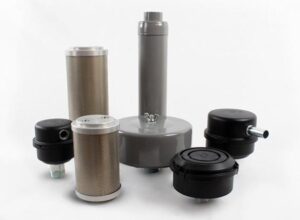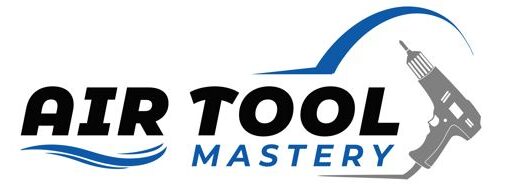Just as their name suggests, air compressor silencers serve the purpose of canceling out the noise produced by an air compressor. As the engines of pneumatic equipment, like air compressors, run, the moving parts produce noise. This noise is often undesirable or a nuisance to many DIYers. The silencer in an air compressor is therefore a must-have for many people who love to work in peace, and in this article, we will cover how it works and how to install one.
Understanding The Cause of Air Compressor Noise
Vibrations: caused by the mechanical motion of the compressor’s parts, especially during the start-up and shut-down phases.
Intake Noise: The sucking of air into the compressor’s chamber can be quite loud, as it moves rapidly through the intake valve.
Exhaust Noise: When compressed air is released, it can create a sharp, loud noise as it exits the exhaust port.
Cooling Fans: The fans used to cool the compressor motor can contribute to the noise level, often producing a consistent background hum.
Enclosure Resonance: If the air compressor is housed within an enclosure, the structure can resonate and amplify the sound produced by the compressor.
Decibel Levels and Noise Measurement
Noise levels are measured in decibels (dB), a unit that expresses the intensity of sound. The decibel scale is logarithmic, meaning that a noise source measured at 70 dB is ten times louder than one measured at 60 dB. Occupational health guidelines typically suggest that sustained exposure to noise levels above 85 dB can result in hearing damage over time. Consequently, understanding and measuring the decibel levels of air compressors is crucial for implementing effective noise reduction strategies.
Common Air Compressor Noise Reduction Techniques
Proper Installation and Regular Maintenance
Proper installation is vital to ensure an air compressor operates at the lowest possible noise level. It includes securing the equipment on a stable foundation to minimize vibration noise. Regular maintenance matters too, as worn or damaged components can lead to increased operational noise. Routine checks and timely repairs can keep noise levels in check and prevent sudden spikes that may violate noise regulations.
Use of Sound-Absorbing Materials
Implementing sound-absorbing materials around air compressors can significantly dampen noise emissions. Acoustic barriers, such as foam pads or sound curtains, can enclose noisy parts and absorb vibrations before they travel through the air. This strategy is particularly effective in areas where soundproofing is essential, like near workstations or within residential vicinities.
Optimizing Compressor Operation Cycles
Optimizing the operation cycles of air compressors can also reduce noise pollution. By scheduling the operation of compressors during times when noise sensitivity is lower, such as during middle-day hours in industrial areas, the impact of the noise can be lessened. Additionally, using multiple smaller compressors staggered over time can be more efficient and quieter than one larger compressor running continuously.
Silencing Equipment
Types of Silencing Equipment
Silencing equipment is essential for further reducing noise levels from air compressors. Here are some common types:
Mufflers
Mufflers, or silencers, are designed to attenuate noise through a series of tubes and chambers that disrupt and diffuse sound waves. These are often installed in the exhaust systems of compressors to reduce the emitted sound.
Silencer Boxes
Silencer boxes encase the compressor unit and utilize sound-absorbing materials. They are engineered to contain and absorb the noise emitted from all sides of the equipment, drastically reducing the overall sound level.
Sound Blankets and Enclosures
Sound blankets are flexible, easy to install, and can be wrapped around noisy components. Sound enclosures are rigid structures that offer a more permanent solution, significantly reducing the noise by isolating the equipment from the surrounding environment.
Criteria for Selecting the Right Silencing Equipment
When selecting the right silencing equipment, it’s imperative to consider factors such as the frequency and decibel level of the noise, the size of the compressor, and the specific environmental requirements of the workspace. Additionally, the ease of installation, maintenance needs, and the regulation compliance of the silencing solution should inform the final decision to ensure effective noise pollution control.
Types of Air Compressor Silencers

Air Compressor Exhaust Silencer
One of the most effective ways to reduce noise pollution from air compressors is by installing an exhaust silencer. These devices are designed to attenuate the sound produced during the exhaust phase of operation. By disrupting the flow of exhaust air and absorbing sound waves, exhaust silencers significantly lower the decibel level emitted.
Air Compressor Silencer Muffler
The air compressor silencer muffler works on a similar principle to automotive mufflers, incorporating both reactive and absorptive elements to dampen sound. Reactive components disrupt the sound waves within the muffler, while absorptive materials help to soak up the sound energy, thus reducing noise.
Air Compressor Intake Silencer
An intake silencer focuses on reducing noise at the source by attenuating the sound generated during the air intake phase. This is particularly important because the intake phase can significantly contribute to overall noise levels, especially in larger compressors.
Air Compressor Muffler Silencer
When it comes to comprehensive noise management, the air compressor muffler silencer is a versatile solution that targets both intake and exhaust noises. These devices can be critical in environments where even minor reductions in noise can have significant improvements in ambient workplace conditions.
DIY Silencing Methods
Step-by-step Guide on DIY Silencing Projects
Step 1: Assess the Situation
Begin by determining the source and intensity of the noise. Use a decibel meter to measure the sound levels around your compressor to get an idea of the degree of silencing required.
Step 2: Gather Materials
Collect the necessary materials, such as:
- Sound-absorbing foam or mass-loaded vinyl
- Acoustic sealant
- Weatherstripping
- Plywood or MDF boards for constructing enclosures
- Fasteners and connectors
- Tools like a hammer, saw, drill, and measuring tape
Step 3: Building Sound Blankets
Cut the sound-absorbing material to size and wrap it around the compressor or specific noisy components, securing them with fasteners where necessary.
Step 4: Constructing an Enclosure
Using plywood or MDF, build a box that is larger than the compressor. Line it with sound-absorbing foam and seal the edges with acoustic sealant for maximum efficiency.
Step 5: Install Weather Stripping
Attach weather stripping around the door or access panel of the enclosure to ensure a tight seal, further preventing sound leakage.
Step 6: Assemble and Test
Assemble the enclosure around the compressor, ensuring that there is sufficient ventilation. Test by running the compressor and using the decibel meter to confirm reduced noise levels.
Precautions and Tips for DIY Silencer Installations
- Safety First: Wear protective gear like gloves, eye protection, and ear protection when constructing and installing silencers.
- Ventilation is Key: Compressors need adequate air flow; ensure the design of DIY enclosures does not obstruct ventilation to prevent overheating.
- Regular Maintenance: Check that any DIY solutions do not hinder access to the compressor for regular maintenance.
- Compliance with Regulations: Review local regulations about noise control to ensure your DIY solutions are compliant.
- Professional Advice: If you’re unsure about the project, consult with a professional. Incorrectly installed silencing can damage your compressor or be ineffective.
Conclusion
Reducing the noise from air compressors is not only about comfort, but it is also a matter of health and operational efficiency. A quieter work environment can prevent hearing loss, reduce stress, and improve focus, leading to heightened productivity. By following the detailed steps we’ve outlined—from selecting materials to installation—it is possible to create a significant reduction in compressor noise.
In closing, remember that the initiative to silence a noisy compressor is an investment in the well-being of people and the functionality of workspaces. Regularly evaluating the effectiveness of your silencing measures and staying open to new solutions will contribute to maintaining a serene environment. The key is to balance the need for noise reduction with the safe and efficient operation of the equipment, always adhering to safety regulations and best practices.

